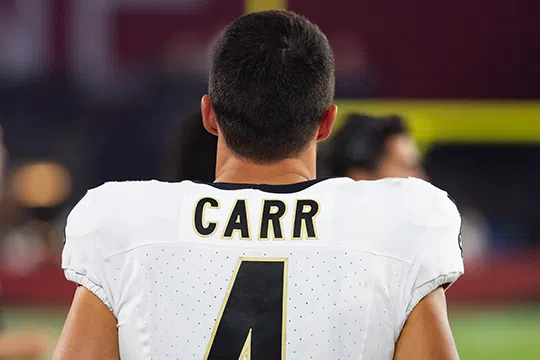By Ross Jackson
Derek Carr’s retirement didn’t just close the book on a short-lived Saints tenure, it cracked open a massive financial opportunity. While the salary cap implications were initially complex, the picture has quickly come into focus. Bottom line: this is a major win for New Orleans and its future roster-building flexibility.
The prevailing logic was that New Orleans would simply recoup Carr’s $30 million base salary. But that was an optimistic prediction. With Carr’s retirement not being processed until after June 1, per Nick Underhill of NewOrleans.Football, prorations and deferments would change the accounting of the $30 million figure.
Here’s everything you need to know about what the Saints will save, when, and how it all works.
Why is June 1 important?
The June 1 deadline is most often associated with salary cap savings from player releases, but it also significantly affects trades and retirements. That’s because after June 1, teams can split the dead money (or guaranteed salary owed to players no longer on the roster) across two seasons, easing the immediate cap hit.
Think about a dollar spread over four years, one quarter a piece. If that dollar is fully guaranteed to a player, (which is always the case when dealing with restructured funds) and that player is released before June 1, the team is on the hook for that dollar immediately. However, if the player is released, traded, or retires after June 1, the team would only be on the hook for one quarter, while the remaining 75 cents would defer to next season.
Because Carr’s deal was restructured, processing his retirement after June 1 will have a similar impact, but with a much larger and more complicated sum of money.
What is a restructure?
Generally speaking, a restructure allows a team to take a portion of money set to be paid out to a player, convert it to signing bonus and prorate (or spread out in even portions) the expense over multiple seasons.
In this instance, the Saints restructured $40 million of Carr’s cap hit in 2025. This included an already guaranteed $10 million roster bonus and the majority of his $30 million base salary by reducing it to the minimum contract for veterans with his experience ($1.255 million). This allowed the Saints to lighten their books for 2025 without costing Carr any money.
But with Carr retiring, he’s set to return the original $30 million base salary, starting with that veteran minimum amount in 2025.
Both sides gain financially — By retiring, Carr forgoes the $30M guaranteed this season, while the Saints won’t seek reimbursement for the $10M roster bonus and signing bonus. https://t.co/uAyfRErYTZ
— Ian Rapoport (@RapSheet) May 10, 2025
How much will the Saints save in 2025?
The belief is that the Saints will get Carr’s $1.255 million base salary back upon his retirement posting on June 2.
Because his retirement is being processed after the key June 1 date, the Saints can’t fully reverse his contract restructure or recoup the entire amount. But don’t worry, New Orleans will instead recoup the bulk of their initial investment when it matters most: in 2026.
How much will the Saints save in 2026?
The remaining $28.745 million will reduce Carr’s dead 2026 cap hit, which was originally $59.67 million. That saves the Saints more than $28 million next year.
Saints will save $30M in cash this year and eventually close to $30M in cap space with Derek Carr’s retirement. But almost all cap savings will wait until 2026.
For now, Carr’s $1.255M salary will come off books June 2 (but be replaced by a different minimum salary in top 51) …
— Mike Triplett (@MikeTriplett) May 11, 2025
Why does that matter?
This arrangement is an unexpected win for New Orleans despite the loss of their starting passer. The Saints are currently expected to be $42.7 million over the salary cap next season. That number is now set to take a steep drop.
This would drop the Saints to managing just about $14 million of salary cap overage. That’s small potatoes for a team that cleared over $100 million back in 2021.
What else will help their salary cap situation?
Along with this savings, the Saints are still set to roll a helpful amount of available money into next year. Each season, if a team finished with a surplus of cap space, that money can be carried over to the following year, increasing a team’s spending potential in the next offseason.
Right now, New Orleans is sitting comfortably with nearly $28 million of available funds. Bear in mind, a portion of that will go toward signing the team’s rookie class. Additionally, only the top-51 highest-pair contracts on the team’s roster currently counts against the cap. That will eventually expand to the full 53-man roster and practice squad after roster cuts and before the season begins.
If all goes well and the team doesn’t have to sign a pricey free agent before the conclusion of the 2025 season, the Saints could carry over $10 to $15 million into 2026.
That amount would then contribute to chewing away at the salary cap overage. Let’s say New Orleans keeps $10 million free after this year. The Saints would then go from $13 million over the cap to just $3 million.
Add in the ever-rising salary cap and the Saints may even be salary cap compliant as the new league year begins.
What does that mean for the Saints in 2026?
If they want to spend in free agency, they’ll still have to move money around and open up additional funds. That is, if they want to sign higher-caliber players to help build their roster. This could set them up to be further out of the salary cap woods in 2027.
The best thing New Orleans could do after this year is begin the process of shedding the contracts of aging veterans. That would allow them to experience more financial freedom in the coming years.
New Orleans would also benefit by either striking gold with a rookie quarterback or taking another swing at one in next year’s draft. Signal callers are expensive. Not having to give your starter a $150 million contract means the team will have the ability to spend over the next few years to build their roster for the future.
This is exactly what the team needs in order to embark upon its new era.






